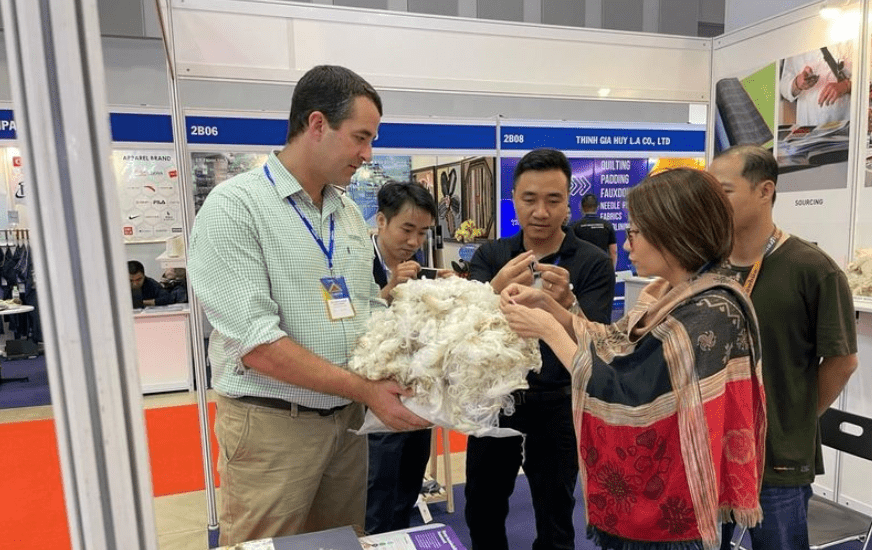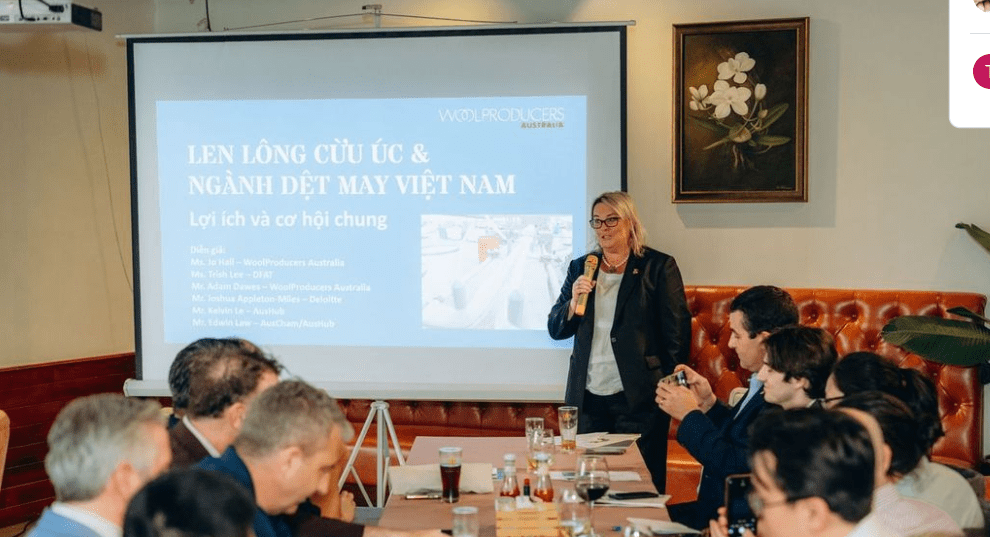
WPA general manager Adam Dawes shows some semi-processed Australian wool to Vietnamese officials at Saigon Tex.
A ROADMAP for early-stage wool processing development in Vietnam has been agreed to and launched with peak grower body WoolProducers Australia and the Australian Government.
A WPA and government delegation launched the roadmap in Vietnam’s most populous centre Ho Chi Minh City last week, while also attending the SaigonTex 2024 textile exhibition.
WPA said the roadmap marks a significant milestone in the economic collaboration between the two countries, especially for the textile industry.
Collaborating in the launch was the Australian Chamber of Commerce, Australia’s Department of Foreign Affairs and Trade, and Deloitte Access Economics. More than 50 industry leaders and government officials attended.
WoolProducers general manager Adam Dawes said Australia is renowned for its high-quality wool, particularly Merino wool.
“Vietnamese textile manufacturers are increasingly recognising the value of incorporating wool into their products, with domestic wool spinning capacity expected to exceed 20,000 metric tonnes in the next 12 months,” he said.
As part of a government funded Agricultural Trade and Market Access Cooperation grant (ATMAC) “Ensuring a sustainable future for Australia’s wool supply chain”, WoolProducers recently explored options to diversify Australian wool exports, which are currently concentrated in greasy (unprocessed) wool to a limited number of markets.
Four countries (China, India, Italy, and the Czech Republic) currently account for more than 95pc of all Australian wool exports.
Vietnam, as an emerging hub for textile production and is considered a potential key partner for trade diversification for direct trade of both greasy and scoured Australian wool, WPA said.
WoolProducers said the Vietnam roadmap sets out clear steps to establish direct trade of greasy and scoured Australian wool to Vietnam. Consultations throughout the ATMAC project found that Vietnamese downstream supply chain partners, including spinners, knitters, weavers, and garment manufacturers had a mutual desire to expand their supply chains to mitigate their procurement risks. To expand Vietnam’s role in the global wool supply chain, a pathway is defined with short, medium, and long-term goals, from developing the first at-scale top making facility, to scaling production to build a thriving industrial presence, WPA said.

WPA chief executive officer Jo Hall presenting during the Vietnam trade delegation.
In addition to the ATMAC project, WoolProducers has partnered with Australian Industry Hub Vietnam (AusHub), a project of the Australian Chamber of Commerce in Vietnam funded by the Australian Department of Foreign Affairs and Trade. Through this project the Australian wool industry has benefited from the presence of wool industry representative, Klevin Le, to assist with the ATMAC project and the development of in-country industry contacts to pursue the ATMAC recommendations.
Mr Le said AusHub has identified complementary supply chain partners for Australian wool market expansion.
“Given Vietnam’s exciting textile trade, predicted growth and rapid expansion in wool processing capacity there are significant benefits to both sides in relation to Australian wool,” he said.
Mr Dawes said the strategic partnership with Vietnam holds promise for both sides.
“Australian wool producers gain access to a new and expanding market, while Vietnamese manufacturers elevate their product offerings with premium wool.
“The global wool supply chain is one of the most complex agri-supply chains in the world,” he said.
“The roadmap sets out clear responsibilities for both industry and government on both sides to integrate wool as a core part of the Vietnamese textile sector.
“Given the importance placed upon expanding trade to the Southeast Asia region we look forward to ongoing commitment from all parties to progress the recommendations of the roadmap and associated action plan, “ Mr Dawes said.



HAVE YOUR SAY